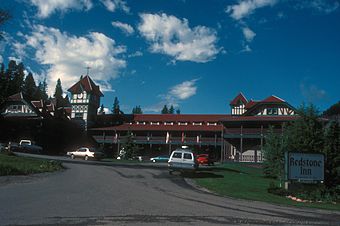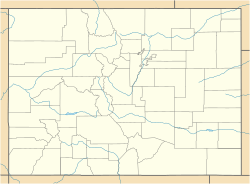Redstone Inn facts for kids
Quick facts for kids |
|
|
Redstone Inn
|
|
|
U.S. Historic district
Contributing property |
|

North elevation from driveway, 2007
|
|
| Location | Redstone, CO |
|---|---|
| Nearest city | Aspen |
| Area | 22 acres (8.9 ha) |
| Built | 1902 |
| Architect | Theodore Boal |
| Architectural style | Tudor Revival |
| Part of | Redstone Historic District (ID89000934) |
| MPS | Mining Industry in Colorado |
| NRHP reference No. | 80000920 |
| Added to NRHP | March 27, 1980 |
The Redstone Inn is a historic building in Redstone, Colorado. It was built over 120 years ago in the Tudor Revival style. This style looks like old English country homes.
The building was first used as a dormitory for single male workers. These men mostly worked in the nearby coal mines and coke ovens. They worked for the Colorado Fuel & Iron (CF&I) company. The inn was part of a special "company town" built by the company's president, John C. Osgood.
The mines closed in 1908, and the town became almost empty. Many buildings were torn down or moved. But the dormitory survived! In the middle of the 20th century, it was fixed up and turned into the inn you see today. In 1980, it was added to the National Register of Historic Places. This means it's an important historical site.
Contents
What the Inn Looks Like
The Redstone Inn sits on a 22-acre (8.9 ha) property. It's located near the Crystal River and Highway 133. This is the main way visitors enter Redstone. The old coke ovens are just across the river.
The main inn building is shaped like a "C". It has two-and-a-half stories and is made of wood. It has a sandstone base and is covered with stucco and wood shingles. You can see half-timbering on the ends of the roof, which is typical for Tudor Revival style.
Special Features of the Building
The roof has gabled dormer windows, which are windows that stick out from the roof. A clock tower rises from the building, adding an extra story. There are also several small extensions at the back.
The front of the building has a wooden balustrade (a fancy railing) on both floors. This allows guests to walk along the outside of their rooms. The second-floor porch is held up by tall wooden pillars. Windows on the ends of the building have diamond-shaped panes, matching the half-timbering.
The clock tower's top part flares out a bit. It has a pyramid-shaped roof with small gables on each side. Inside the inn, there are 35 guest rooms. There's also a restaurant, kitchen, bar, and offices. Some older rooms still have original Arts and Crafts furniture.
Outdoor Areas
Behind the inn, there's a swimming pool with a large concrete area around it. A pool house is to the south. There are also tennis courts on the east side. Closer to the river, there's a small chalet with two rooms.
History of the Redstone Inn
In the 1880s, John C. Osgood discovered many areas in Colorado with good coal. He started mining and processing coal. By 1892, he was in charge of the Colorado Fuel and Iron (CF&I) company. Osgood became one of the richest men in the country. He controlled more than half of Colorado's coal.
Building a Company Town
Osgood wanted to develop the coal in the upper Crystal River valley. This coal could make high-quality coke, which is used to make steel. After some economic difficulties, banks finally agreed to fund his big project.
A major part of his plan was to build a special company town at Redstone, Colorado. Most miners at the time lived in simple shacks. Osgood wanted to create a much better living environment for his workers. He believed this would help avoid problems with workers.
By the end of 1899, 249 coke ovens were built. This was the largest coking facility in Colorado. Many of the workers were immigrants from Eastern Europe. The miners, however, were often long-time Colorado residents.
Redstone: The "Ruby of the Rockies"
Starting in 1900, Osgood spent about $5 million (a huge amount of money back then) to build Redstone. Architect Theodore Boal designed pretty cottages. They fit well with the mountain setting, often in the Swiss Chalet style. More important workers got bigger cottages with electricity and running water. Osgood's own large estate was south of town.
For single workers, there was a 40-room dormitory. This is the building that became the Redstone Inn. It was designed in the "old English style," now called Tudor Revival. The clock tower was inspired by one in Rotterdam, Netherlands. Inside, workers had barbershops, telephones, and reading rooms. They also had electricity and running water.
These luxuries were very rare for mining camps. This earned Redstone the nickname "Ruby of the Rockies." A newspaper in 1902 was amazed that miners changed out of their dirty work clothes for dinner. Osgood even had special rules for social activities. He allowed some activities like card games (penny-ante poker) and drinks for personal use. This helped keep the town orderly. In 1902, Redstone won an award at the St. Louis Exposition.
Decline and Revival
In 1903, Osgood lost control of CF&I due to financial problems. Mining and coking continued until 1909. Then, it became too expensive to ship coal and coke to the company's new steel mill. Most people left Redstone very quickly. The dormitory was abandoned and fell into disrepair.
Over the next few decades, many Redstone buildings were moved or torn down. During World War II, many larger buildings were taken apart for scrap metal.
After the war, coal mining returned to Redstone on a smaller scale in the early 1950s. The old dormitory was then fixed up and reopened as an inn. It was even expanded a bit on the west side, keeping the original style. Some new "terrace rooms" were added.
Staying at the Redstone Inn
The Redstone Inn is open all year. Room prices change, but they are often less expensive than places in nearby Aspen. You can even rent a small single room in the clock tower. Pets are allowed in some rooms for an extra fee.
Inn Amenities
Rooms have flat-screen TVs and most have DVD players. All rooms have satellite TV. The inn offers free wireless Internet throughout the building. There's also a business center on the main floor. You can ask for irons and ironing boards. Please note, there is no elevator in the inn.
A free continental breakfast is offered in the mornings during winter and early spring. The inn's bar and grill serves lunch every day. In the summer, you can eat by the pool. The Dining Room is open on Friday and Saturday nights in winter, and every night in summer.
The inn also helps with other activities. It can arrange tours of the Redstone Castle. It also hosts destination weddings.
What People Say About the Inn
Travel writers love the Redstone Inn's location and its old-fashioned furniture. They call the interior decoration "striking." Nicholas Trotter, a travel writer, said, "I love old Arts and Crafts-style lodges in remote locations, and the Redstone Inn may be my favorite anywhere."
Another writer, Evelyn Spence, agreed. She said the rooms are not super fancy, but the old furniture, antiques, and wallpaper "seem to go together swimmingly."


